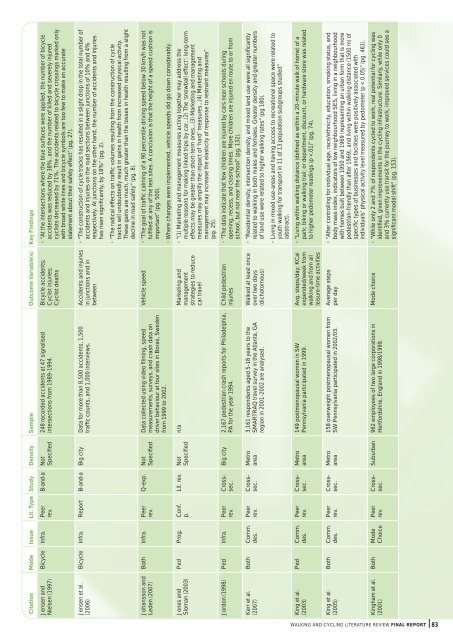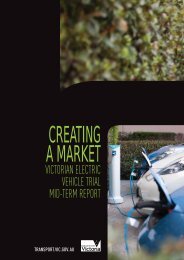Walking and Cycling International Literature Review - Department of ...
Walking and Cycling International Literature Review - Department of ...
Walking and Cycling International Literature Review - Department of ...
You also want an ePaper? Increase the reach of your titles
YUMPU automatically turns print PDFs into web optimized ePapers that Google loves.
Citation Mode Issue Lit. Type Study Density Sample Outcome Variable(s) Key Findings<br />
Jensen <strong>and</strong><br />
Nielsen (1997)<br />
Bicycle Infra. Peer<br />
rev.<br />
B-<strong>and</strong>-a Not<br />
Specified<br />
248 recorded accidents at 47 signalised<br />
intersections from 1989-1994.<br />
Bicycle accidents;<br />
Cyclist injuries;<br />
Cyclist deaths<br />
• “At the intersections where the blue surfaces were applied, the number <strong>of</strong> bicycle<br />
accidents was reduced by 38%, <strong>and</strong> the number <strong>of</strong> killed <strong>and</strong> severely injured<br />
cyclists decreased by 71%. The accidents related to bicycle crossings marked only<br />
with broad white lines <strong>and</strong> bicycle symbols are too few to make an accurate<br />
statement about their safety effect” (pg. 27).<br />
Jensen et al.<br />
(2006)<br />
Bicycle Infra. Report B-<strong>and</strong>-a Big city Data for more than 8,500 accidents, 1,500<br />
traffic counts, <strong>and</strong> 1,000 interviews.<br />
Accidents <strong>and</strong> injuries<br />
in junctions <strong>and</strong> in<br />
between<br />
• “The construction <strong>of</strong> cycle tracks has resulted in a slight drop in the total number <strong>of</strong><br />
accidents <strong>and</strong> injuries on the road sections between junctions <strong>of</strong> 10% <strong>and</strong> 4%<br />
respectively. At junctions on the other h<strong>and</strong>, the number <strong>of</strong> accidents <strong>and</strong> injuries<br />
has risen significantly, by 18%” (pg. 2).<br />
• “The radical effects on traffic volumes resulting from the construction <strong>of</strong> cycle<br />
tracks will undoubtedly result in gains in health from increased physical activity.<br />
These gains are much, much greater than the losses in health resulting from a slight<br />
decline in road safety” (pg. 8).<br />
Johansson <strong>and</strong><br />
Leden (2007)<br />
Both Infra. Peer<br />
rev.<br />
Q-exp. Not<br />
Specified<br />
Data collected using video filming, speed<br />
measurements, surveys, <strong>and</strong> crash data on<br />
driver behaviour at four sites in Boras, Sweden<br />
from 1999 to 2002.<br />
Vehicle speed • “The goal <strong>of</strong> traffic calming <strong>of</strong> a 90 percentile driving speed below 30 km/h was not<br />
fulfilled at any <strong>of</strong> the test sites. A conclusion is that the height <strong>of</strong> a speed cushion is<br />
important” (pg. 500).<br />
• Where changes were implemented, vehicle speeds did go down considerably.<br />
Jones <strong>and</strong><br />
Sloman (2003)<br />
Ped Prog. Conf.<br />
p.<br />
Lit. rev. Not<br />
Specified<br />
n/a Marketing <strong>and</strong><br />
management<br />
strategies to reduce<br />
car travel<br />
• “(1) Marketing <strong>and</strong> management measures acting together may address the<br />
multiple reasons for making linked trips by car...(2) The ‘snowball effect’: long-term<br />
effects may be greater than short-term ones...(3) Marketing <strong>and</strong> management<br />
measures may amplify the impact <strong>of</strong> ‘hard’ measures...(4) Marketing <strong>and</strong><br />
management may increase the elasticity <strong>of</strong> response to restraint measures”<br />
(pg. 25).<br />
Jordon (1998) Ped Infra. Peer<br />
rev.<br />
Big city 2,167 pedestrian crash reports for Philadelphia,<br />
PA for the year 1994.<br />
Child pedestrian<br />
injuries<br />
• “The data indicate that few children are injured by cars near schools during<br />
opening, recess, <strong>and</strong> closing times. More children are injured en route to or from<br />
school, but not near the school” (pg. 132).<br />
Kerr et al.<br />
(2007)<br />
Both Comm.<br />
des.<br />
Peer<br />
rev.<br />
Metro<br />
area<br />
3,161 respondents aged 5-18 years to the<br />
SMARTRAQ travel survey in the Atlanta, GA<br />
region in 2001-2002 are analysed.<br />
Walked at least once<br />
over two days<br />
(dichotomous)<br />
• “Residential density, intersection density, <strong>and</strong> mixed l<strong>and</strong> use were all significantly<br />
related to walking in both males <strong>and</strong> females. Greater density <strong>and</strong> greater numbers<br />
<strong>of</strong> l<strong>and</strong> use were related to higher walking rates” (pg 180).<br />
• Living in mixed use-areas <strong>and</strong> having access to recreational space were related to<br />
youth walking for transport in 11 <strong>of</strong> 13 population subgroups studied”<br />
(abstract).<br />
King et al.<br />
(2003)<br />
Ped Comm.<br />
des.<br />
Peer<br />
rev.<br />
Metro<br />
area<br />
149 postmenopausal women in SW<br />
Pennsylvania participated in 1999.<br />
Avg. steps/day; KCal<br />
expended/week from<br />
walking <strong>and</strong> from all<br />
leisure-time activities<br />
• “Living within walking distance (defined as within a 20-minute walk <strong>of</strong> home) <strong>of</strong> a<br />
park; biking or walking trail; or department, discount, or hardware store was related<br />
to higher pedometer readings (p

















